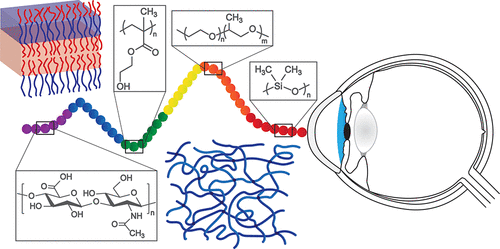当前位置:
X-MOL 学术
›
Biomacromolecules
›
论文详情
Our official English website, www.x-mol.net, welcomes your feedback! (Note: you will need to create a separate account there.)
Polymeric Materials for Eye Surface and Intraocular Applications
Biomacromolecules ( IF 6.2 ) Pub Date : 2021-01-06 , DOI: 10.1021/acs.biomac.0c01525 Metin Karayilan 1 , Liane Clamen 2 , Matthew L Becker 1, 3
Biomacromolecules ( IF 6.2 ) Pub Date : 2021-01-06 , DOI: 10.1021/acs.biomac.0c01525 Metin Karayilan 1 , Liane Clamen 2 , Matthew L Becker 1, 3
Affiliation

|
Ocular applications of polymeric materials have been widely investigated for medical diagnostics, treatment, and vision improvement. The human eye is a vital organ that connects us to the outside world so when the eye is injured, infected, or impaired, it needs immediate medical treatment to maintain clear vision and quality of life. Moreover, several essential parts of the eye lose their functions upon aging, causing diminished vision. Modern polymer science and polymeric materials offer various alternatives, such as corneal and scleral implants, artificial ocular lenses, and vitreous substitutes, to replace the damaged parts of the eye. In addition to the use of polymers for medical treatment, polymeric contact lenses can provide not only vision correction, but they can also be used as wearable electronics. In this Review, we highlight the evolution of polymeric materials for specific ocular applications such as intraocular lenses and current state-of-the-art polymeric systems with unique properties for contact lens, corneal, scleral, and vitreous body applications. We organize this Review paper by following the path of light as it travels through the eye. Starting from the outside of the eye (contact lenses), we move onto the eye’s surface (cornea and sclera) and conclude with intraocular applications (intraocular lens and vitreous body) of mostly synthetic polymers and several biopolymers. Initially, we briefly describe the anatomy and physiology of the eye as a reminder of the eye parts and their functions. The rest of the Review provides an overview of recent advancements in next-generation contact lenses and contact lens sensors, corneal and scleral implants, solid and injectable intraocular lenses, and artificial vitreous body. Current limitations for future improvements are also briefly discussed.
中文翻译:

眼表和眼内应用的聚合材料
聚合物材料的眼部应用已被广泛研究用于医学诊断,治疗和视力改善。人眼是连接我们与外界的重要器官,因此当眼睛受伤,感染或受损时,需要立即进行医疗以维持清晰的视力和生活质量。此外,眼睛的一些主要部位会随着年龄的增长而失去功能,从而导致视力下降。现代高分子科学和高分子材料提供了多种替代方案,例如角膜和巩膜植入物,人造晶状体和玻璃体替代物,以替代受损的眼睛部分。除了将聚合物用于医疗之外,聚合物隐形眼镜不仅可以提供视力矫正,还可以用作可穿戴电子设备。在这篇评论中,我们重点介绍了用于特殊眼科应用(例如眼内透镜)的聚合物材料的发展以及具有隐形眼镜,角膜,巩膜和玻璃体应用的独特特性的当前最先进的聚合物系统。我们通过遵循光在眼睛中传播的路径来组织此评论论文。从眼睛(隐形眼镜)的外部开始,我们移到眼睛的表面(角膜和巩膜),最后以眼内应用(眼内透镜和玻璃体)使用大多数合成聚合物和几种生物聚合物。最初,我们简要描述眼睛的解剖结构和生理机制,以提醒人们眼部及其功能。该评论的其余部分概述了下一代隐形眼镜和隐形眼镜传感器,角膜和巩膜植入物,固体和可注射人工晶状体,以及人工玻璃体。还简要讨论了当前对未来改进的限制。
更新日期:2021-02-08
中文翻译:

眼表和眼内应用的聚合材料
聚合物材料的眼部应用已被广泛研究用于医学诊断,治疗和视力改善。人眼是连接我们与外界的重要器官,因此当眼睛受伤,感染或受损时,需要立即进行医疗以维持清晰的视力和生活质量。此外,眼睛的一些主要部位会随着年龄的增长而失去功能,从而导致视力下降。现代高分子科学和高分子材料提供了多种替代方案,例如角膜和巩膜植入物,人造晶状体和玻璃体替代物,以替代受损的眼睛部分。除了将聚合物用于医疗之外,聚合物隐形眼镜不仅可以提供视力矫正,还可以用作可穿戴电子设备。在这篇评论中,我们重点介绍了用于特殊眼科应用(例如眼内透镜)的聚合物材料的发展以及具有隐形眼镜,角膜,巩膜和玻璃体应用的独特特性的当前最先进的聚合物系统。我们通过遵循光在眼睛中传播的路径来组织此评论论文。从眼睛(隐形眼镜)的外部开始,我们移到眼睛的表面(角膜和巩膜),最后以眼内应用(眼内透镜和玻璃体)使用大多数合成聚合物和几种生物聚合物。最初,我们简要描述眼睛的解剖结构和生理机制,以提醒人们眼部及其功能。该评论的其余部分概述了下一代隐形眼镜和隐形眼镜传感器,角膜和巩膜植入物,固体和可注射人工晶状体,以及人工玻璃体。还简要讨论了当前对未来改进的限制。



























 京公网安备 11010802027423号
京公网安备 11010802027423号